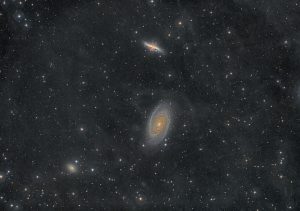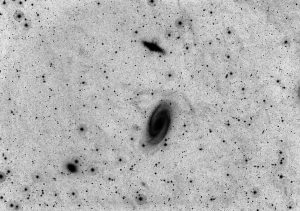Set-up

Used my Esprit 100 ED with the Riccardi which results in a 100 mm f/4.1 scope. Atik 383 L+ with Baader LRGB filters. All on the Avalon Linear guided with a 60 mm finder scope. The nights have been: 2017 March, 23./24./26./27. and April, 26./28./29./30. I took only 8 min frames in order to prevent the core of M81 from saturation. This sounds strange, but with f/4.1 the M81 center really came close to the full CCD range, hence I decided to be on the safe side. At the end of the day – after blinking, FHWM and excentricity measurements – a few frames had been rejected and I had 99/22/21/21 frames of the LRGB channels which equal almost 22 h exposure time.
M81 Group
The M81 Group is a galaxy group in the constellations Ursa Major and Camelopardalis that includes the galaxies Messier 81 and Messier 82, as well as several other galaxies with high apparent brightnesses. The group covers an angle of about 40° × 20°. The approximate center of the group is located at a distance of 3.6 Mpc, making it one of the nearest groups to the Local Group. The distance of the three large galaxies of the picture are all quite similar, as it should be for a group: from 11.5 Mly (M82) over 11.9 Mly (M81) to 12.8 Mly (NGC3077) [wikipedia]. Find here a wide field of this area.
A deep exposure and a careful processing reveals that these galaxies are surrounded by huge clouds of dust. The truth is that the galaxies are not surrounded by this dust – the dust is much closer to us than the galaxies – it just happens to look that way. It is basically the dust and dirt of our Milky Way. This dust, unlike classic reflection nebulas – that are usually illuminated by neighboring stars – is actually illuminated by the glow of our own Milky Way [ESA/Hubble]. It is reported that Steve Mandel named this nebulosity Integrated Flux Nebula (IFN) [astrosociety].
The picture shows a field of 2.4° x 1.7°. The original scale is 2.7 arcsec/pix. In contrast to many other publications north is almost up (PW=178°). The center of the image is RA: 09h 56h 19s DE: +69° 13′ 02″.
Processing
Picture processing was a hard job. Mostly carried out in PI, I tried to focus on two issues:
- Push the flux background as much as possible. Anyway not to blow up the stars. Find the right way somewhere between fully denoised creamy nebulas and grainy background.
- Avoid pushing the galaxies to much and keep the level of the galaxies low enough. Compress the dynamics of the galaxies as much as necessary but keep the impression as natural as possible.
The final composition of the pic was done in PS. Also some optimizations (sharpening of parts, partly denoising of the flux) was done here. Last but not least I would say that the picture took about 11 h exposure time and more than 50 h processing time distributed threw two months with intermissions.

The picture shows the integrated luminance (13 h) pushed using a ingenious method described by G. Wechselberger: Enhance Nebula without pushing the Stars. The tutorial can be found at skypixels. The result of the pushing was used for LRGB combination. I inverted a copy of the result and streched it further in order to reveal more of the flux nebula.
Lessons learnt
The flux nebula needs:
- Dark sky. I spent one night out in the field of Breddorfer Moor, which is significant darker than my suburban garden. During this night much more flux revealed than during all other nights.
- Really long exposure times. I planned 10 h for luninance only. Which was a good plan, but my impatience forced me to start with the proscessing this year. Maybe I prolongate the exposure next year.
- Processing of the flux is difficult. I needed many trys, rejecting most of them. There is still much to learn.